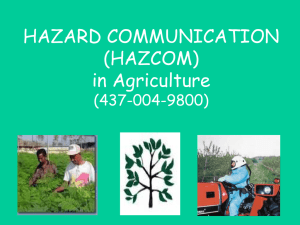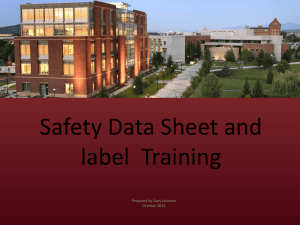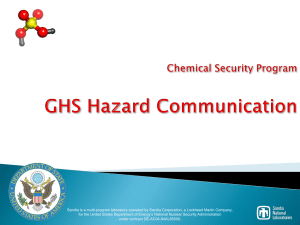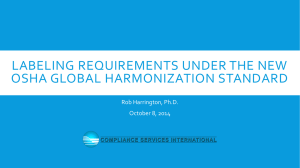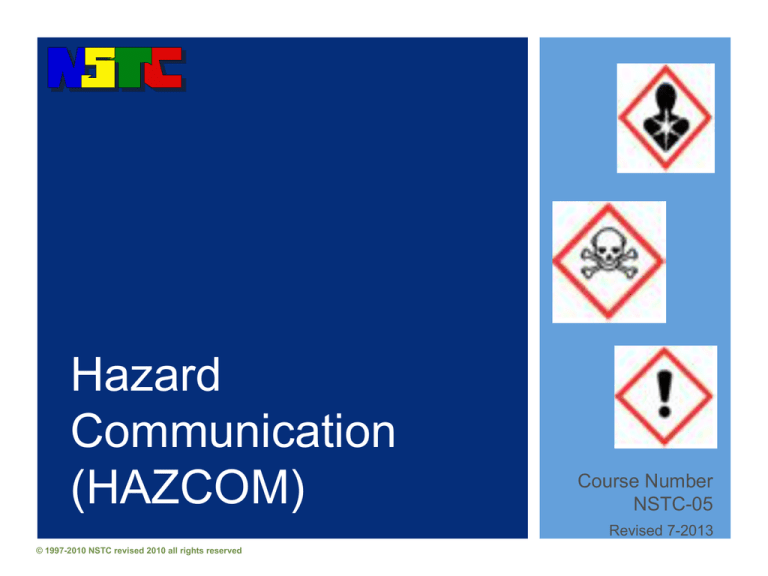
Hazard
Communication
(HAZCOM)
Course Number
NSTC-05
Revised 7-2013
© 1997-2010 NSTC revised 2010 all rights reserved
Introduction
2
© 1997-2010 NSTC revised 2010 all rights reserved
HAZCOM NSTC-05
Goal
3
To ensure participants can recognize the health
and physical hazards of chemicals used in the
workplace and take steps to control those
hazards in accordance with OSHA 29 CFR
1910.1200.
© 1997-2010 NSTC revised 2010 all rights reserved
HAZCOM NSTC-05
Objectives
4
Participants will be able to:
Explain the purpose of the 2012 Hazard
Communication Standard.
Explain the components of a hazard
communication program.
Use hazard classifications, product labeling,
safety data sheets, and other resources to
identify and control the physical and health
hazards of chemicals used in the workplace.
© 1997-2010 NSTC revised 2010 all rights reserved
HAZCOM NSTC-05
HAZCOM STANDARD
AND DEFINITIONS
5
© 1997-2010 NSTC revised 2010 all rights reserved
HAZCOM NSTC-05
Hazardous Chemical
6
The OSHA definition of a hazardous
chemical is any chemical which is classified
as a physical or health hazard, a simple
asphyxiant, combustible dust, pyrophoric
gas, or hazard not otherwise classified.
© 1997-2010 NSTC revised 2010 all rights reserved
HAZCOM NSTC-05
OSHA, 29 CFR 1910.1200(c)
Hazard Communication
Standard
7
The Hazard Communication Standard
(OSHA 29 CFR 1910.1200) requires
employers to establish hazard
communication programs to transmit
information on the hazards of chemicals
in the workplace.
This standard emphasizes that all
employees have a "right-to-know" the
hazards and identities of the chemicals in
the workplace.
The intent is to reduce the incidence of
chemically—related occupational
illnesses and injuries.
© 1997-2010 NSTC revised 2010 all rights reserved
HAZCOM NSTC-05
OSHA 29 CFR 1910.1200
2012 Hazard Communication
Standard: An Update
8
The purpose of the 2012 Hazard
Communication Standard (OSHA 29 CFR
1910.1200) is to update the regulation to be
consistent with the provisions of the United
Nations Globally Harmonized System of
Classifying and Labeling of Chemicals (GHS).
This modified standard provides a single set of
harmonized criteria for classifying chemicals
according to their health and physical hazards.
It specifies new requirements for labeling and
safety data sheets while maintaining the
purpose of the original standard.
© 1997-2010 NSTC revised 2010 all rights reserved
HAZCOM NSTC-05
OSHA 29 CFR 1910.1200
Changes to the HAZCOM
Standard
9
Hazard Classification: Expanded
hazard classification for chemical
manufacturers and importers.
Labels: New labeling requirements.
Safety Data Sheets or SDS:
(formerly Material Safety Data Sheets
or MSDS)
Information and Training: Workers
must be trained by December 1, 2013
on the new label requirements and
SDS formats in addition to current
training requirements.
© 1997-2010 NSTC revised 2010 all rights reserved
HAZCOM NSTC-05
OSHA 29 CFR 1910.1200
HAZCOM Communication
Responsibilities
Chemical Importers &
Manufacturers
Employers
10
Employees
Determine the health
and physical hazards
Develop, implement and
maintain a written
HAZCOM program
Recognize symbols
and statements on
container labels and
and SDS
Provide container and
shipping labels
Inform employees about
the program
Follow instructions
and warnings
Provide an SDS for
each manufactured or
imported product
Train employees to read
labels and SDS and take
the recommended
precautions
Take the
recommended
precautions
© 1997-2010 NSTC revised 2010 all rights reserved
HAZCOM NSTC-05
OSHA 29 CFR 1910.1200
HAZCOM Program Elements
11
Employee training
Hazardous
chemicals list
Provide SDS for
employees
Labeling
Communication
with employees
© 1997-2010 NSTC revised 2010 all rights reserved
HAZCOM NSTC-05
BP ASH page 22; ASH, page 8
Health Hazard Classification
A.1: Acute Toxicity
12
A.6: Carcinogenicity
A.2: Skin Corrosion/Irritation A.7: Reproductive Toxicity
A.3: Serious Eye Damage
/Irritation
A.8: Specific Target Organ
Toxicity: Single Exposure
A.4: Respiratory/Skin
Sensitization
A.9: Single Target Organ Toxicity:
Repeated or Prolonged Exposure
A.5: Germ Cell Mutagenicity A.10: Aspiration Hazard
© 1997-2010 NSTC revised 2010 all rights reserved
HAZCOM NSTC-05
OSHA, 29 CFR 1910.1200, Appendix A
Physical Hazard
Classification
13
B.1: Explosives
B.9: Pyrophoric Liquids
B.2: Flammable Gases
B.10: Pyrophoric Solids
B.3: Flammable Aerosols
B.11: Self-Heating Chemicals
B.4: Oxidizing Gases
B.5: Gases Under Pressure
B. 12 Water Reactive Chemicals
Which Emit Flammable Gases
B.6: Flammable Liquids
B.13: Oxidizing Liquids
B.7: Flammable Solids
B.14: Oxidizing Solids
B.8: Self-Reactive Chemicals B. 15: Organic Peroxides
B. 16: Corrosive to Metals
© 1997-2010 NSTC revised 2010 all rights reserved
HAZCOM NSTC-05
OSHA, 29 CFR 1910.1200, Appendix B
Basic Toxicology
Acute vs. Chronic Health Effects
Local vs. Systemic Health Effects
Routes of Entry
Inhalation
Absorption (skin and eyes)
Ingestion (dust and liquids)
Injection
Dose / Response
© 1997-2010 NSTC revised 2010 all rights reserved
HAZCOM NSTC-05
14
LABELS
15
© 1997-2010 NSTC revised 2010 all rights reserved
HAZCOM NSTC-05
Container Label
Requirements
16
Product identifier
Signal word
Hazard statement(s)
Pictogram(s)
Precautionary statement(s)
Name, address, and telephone number
of the chemical manufacturer, importer or
other responsible party
OSHA 29 CFR 1910.1200 (g)
© 1997-2010 NSTC revised 2010 all rights reserved
HAZCOM NSTC-05
Product Identifier and Signal
Word
17
The product identifier is the name or
number used for a hazardous chemical
on a label or Safety Data Sheet Name of
the chemical or
The signal word is an alert that indicates
the relative level of severity of the
hazardous chemical. “Danger” is used for
most severe hazards and “Warning” is
used for less severe hazards.
OSHA 29 CFR 1910.1200 (c )
© 1997-2010 NSTC revised 2010 all rights reserved
HAZCOM NSTC-05
Hazard Statements
18
Hazard statements describe the nature of
the hazard such as:
Fatal if swallowed
May cause allergic skin reaction
May cause genetic defects
May cause cancer
Causes drowsiness or dizziness
Explosive, severe fire, blast or projection
hazard
OSHA 29 CFR 1910.1200 (c ); Appendix C
© 1997-2010 NSTC revised 2010 all rights reserved
HAZCOM NSTC-05
Pictograms
19
Environment
Black hazard symbol on a white
background
Placed within a red square frame set on
a point
Different hazard symbol for each of the 9
hazard classes
Eight mandatory pictograms
Non-mandatory
Acquatic Toxicity
One non-mandatory pictogram
OSHA 29 CFR 1910.1200, Appendix C
© 1997-2010 NSTC revised 2010 all rights reserved
HAZCOM NSTC-05
Pictograms (Mandatory)
Flame
20
Flame Over Circle
Exclamation Mark
Oxidizers
Irritant
Dermal Sensitizer
Acute Toxicity
(harmful)
Narcotic Effects
Respiratory Tract
Irritation
Flammables
Self Reactives
Pyrophorics
Self-heating
Emits Flammable
Gas
Organic Peroxides
Exploding Bomb
Explosives
Self Reactives
Organic
Peroxides
OSHA 29 CFR 1910.1200, Appendix C
© 1997-2010 NSTC revised 2010 all rights reserved
HAZCOM NSTC-05
Pictograms (Mandatory)
Corrosives
Gases Under Pressure
Corrosives
Gases Under
Pressure
OSHA 29 CFR 1910.1200, Appendix C
© 1997-2010 NSTC revised 2010 all rights reserved
HAZCOM NSTC-05
Health Hazard
Carcinogen
Respiratory
Sensitizer
Reproductive
Toxicity
Target Organ
Toxicity
Mutagenicity
Aspiration Toxicity
21
Skull and Crossbones
Acute Toxicity
(severe)
Types of Precautionary
Statements
22
Prevention: Wash hands thoroughly after handling.
Response: “If swallowed, immediately call a poison
center/doctor….”
Storage: “Store in a well-ventilated place. Keep
container tightly closed.”
Disposal: “Dispose of contents/container to…in
accordance with local, regional, national,
international regulations (to be specified).
OSHA 29 CFR 1910: 1200, Appendix C
© 1997-2010 NSTC revised 2010 all rights reserved
HAZCOM NSTC-05
Sample Label
23
OSHA 29 CFR 1910.1200 (g)
© 1997-2010 NSTC revised 2010 all rights reserved
HAZCOM NSTC-05
Sample Label
24
OSHA 29 CFR 1910.1200 (g)
© 1997-2010 NSTC revised 2010 all rights reserved
HAZCOM NSTC-05
OTHER HAZCOM SYSTEMS
25
© 1997-2010 NSTC revised 2010 all rights reserved
HAZCOM NSTC-05
NFPA 704 Standard
© 1997-2010 NSTC revised 2010 all rights reserved
HAZCOM NSTC-05
26
NFPA Diamond Exercise
What does each color,
number and symbol in this
placard mean?
© 1997-2010 NSTC revised 2010 all rights reserved
HAZCOM NSTC-05
27
Hazardous Materials
Identification System (HMIS)
Developed by the National Paint and
Coatings Association
HEALTH
Health Hazard (BLUE) - possibility of injury
4 = could cause death or irreversible injury
3 = could cause serious temporary or irreversible injury
2 = could cause temporary incapacitation
1 = could cause irritation
0 = no health hazard.
Flammability (RED) - possibility of ignition
4 = flammable vapor or gas which burns readily
3 = flammable liquid or solid which can be readily
ignited
2 = must be heated for ignition
1 = must be preheated before ignition can occur
0 = no fire hazard
FLAMMABILITY
REACTIVITY
Reactivity (YELLOW) - possibility of reaction
4 = readily capable of detonation or explosive reaction
3 = may detonate when exposed to heat of initiating
source
2 = readily capable of nonexplosive reaction
1 = may become unstable at high temperatures
0 = stable materials
PERSONAL
PROTECTION
© 1997-2010 NSTC revised 2010 all rights reserved
28
HAZCOM NSTC-05
Hazardous Materials
Identification System
© 1997-2010 NSTC revised 2010 all rights reserved
HAZCOM NSTC-05
29
DOT Placards*
30
*HAZWOPER Module
© 1997-2010 NSTC revised 2010 all rights reserved
HAZCOM NSTC-05
2012 ERG, pages 16-17
NFPA vs. DOT Placards
31
NFPA Diamond
0–4 = Increasing severity
of hazard
4 colors = Hazard types
Posted on buildings and
containers
DOT Placard
1–9 = Hazard classes
Colors and color
combinations = Hazard
classes
4 digit ID number or code =
Specific hazardous
substance
Posted on railroad cars,
trucks, trailers, and tanks
© 1997-2010 NSTC revised 2010 all rights reserved
HAZCOM NSTC-05
2012 ERG, pages 16-17
SDS and PADS
32
© 1997-2010 NSTC revised 2010 all rights reserved
HAZCOM NSTC-05
Safety Data Sheet (SDS)
The best source for information about the
product
Core element of the HAZCOM Program
Different formats and forms
Employer must have one for each product in
the workplace
Use the latest version
© 1997-2010 NSTC revised 2010 all rights reserved
HAZCOM NSTC-05
33
Accessing an SDS
Hard Copies
Supervisor
Safety Department
Industrial Hygienists
Safety Coordinator
Company Database
© 1997-2010 NSTC revised 2010 all rights reserved
HAZCOM NSTC-05
34
Sections of an SDS
35
Section 1: Identification
Product identifier, manufacturer’s name, address,
emergency number
Section 2: Hazards Identification
All hazards regarding chemical; required label elements
Section 3: Composition & Information on Ingredients
Chemical ingredients and trade secret claims
Section 4: First Aid Measures
Symptoms and effects; required treatment
OSHA 29 CFR 1910.1200, Appendix D
© 1997-2010 NSTC revised 2010 all rights reserved
HAZCOM NSTC-05
Sections of an SDS
36
Section 5: Firefighting Measures
Basic firefighting and extinguishing methods
Section 6: Accidental Release Measures
Emergency procedures; protective equipment,
methods of containment and cleanup
Section 7: Handling and Storage
Procedures for safe handling and storage
OSHA 29 CFR 1910.1200, Appendix D
© 1997-2010 NSTC revised 2010 all rights reserved
HAZCOM NSTC-05
Sections of an SDS
37
Section 8: Exposure Controls and PPE
Permissible exposure and threshold limits,
appropriate engineering controls and PPE
Section 9: Physical and Chemical Properties
Characteristics of the chemical
Section 10: Stability and Reactivity
Chemical stability and hazardous reactions
Section 11: Toxicological Information
Routes of exposure, symptoms, toxicityOSHA 29 CFR 1910.1200, Appendix D
© 1997-2010 NSTC revised 2010 all rights reserved
HAZCOM NSTC-05
Sections of an SDS
38
Additional sections regulated by other agencies and
not enforced by OSHA
Section 12: Ecological Information
Section 13: Disposal Considerations
Section 14: Transport Information
Section 15: Regulatory Information
Section 16: Other Information
OSHA 29 CFR 1910.1200, Appendix D
© 1997-2010 NSTC revised 2010 all rights reserved
HAZCOM NSTC-05
Physical Agent Data Sheets
(PADS)
39
The State of Alaska regulates 8 physical
hazards in the workplace.
The State provides data sheets related to those
hazards called PADS.
The physical hazards covered by the PADS are:
heat stress
laser
hand/arm
vibration
ionizing
radiation
cold stress
noise
radio frequency/
microwave
ultraviolet
exposure
© 1997-2010 NSTC revised 2010 all rights reserved
HAZCOM NSTC-05
State of Alaska: PADS
© 1997-2010 NSTC revised 2010 all rights reserved
HAZCOM NSTC-05
40
http://www.labor.state.ak.us/lss/pads/pads.htm
SDS Exercise
The purpose of this exercise is to become
familiar with how to read and understand an
SDS.
Working in small groups of 2–5, use the
sample SDS to answer the questions in the
handout. Let the instructor know when you
are finished.
Groups will report back and discuss their
answers.
© 1997-2010 NSTC revised 2010 all rights reserved
HAZCOM NSTC-05
41
Hazard Control Measures
42
Engineering Controls
(detection, ventilation,
shielding)
Administrative Controls
(substitution, employee
rotation, training)
Personal Protective
Equipment (PPE)
(goggles, gloves, boots)
© 1997-2010 NSTC revised 2010 all rights reserved
HAZCOM NSTC-05
ASH page 1; BP ASH, page 39
Hazard Communication
Summary
Identify hazards before you start the job
Read labels and SDS/PADS
Follow warnings and instructions
Use correct PPE
Label containers
© 1997-2010 NSTC revised 2010 all rights reserved
HAZCOM NSTC-05
43
DELETED SLIDES
44
© 1997-2010 NSTC revised 2010 all rights reserved
HAZCOM NSTC-05
Objectives
45
Participants will be able to:
Describe methods for detecting the presence
or release of hazardous chemicals. (Omit)
© 1997-2010 NSTC revised 2010 all rights reserved
HAZCOM NSTC-05
Hazardous Substance
46
The OSHA definition of a hazardous
substance is any biological agent and other
disease-causing agent which after release
into the environment and upon exposure,
ingestion, inhalation, or assimilation into any
person...will or may reasonably be
anticipated to cause death, disease,
behavioral abnormalities, cancer, genetic
mutation, physiological malfunctions...or
physiological deformations in such persons
or their offspring.
© 1997-2010 NSTC revised 2010 all rights reserved
HAZCOM NSTC-05
OSHA, 29 CFR 1910.120 (a) (3)
Container Label Exercise
47
Working with a partner seated next to
you, read the label on the container
provided by the instructor and see if you
can find the elements listed on the next
slide.
The container that you are using may not
have all the requirements listed.
OSHA 29 CFR 1910.1200 (f)
© 1997-2010 NSTC revised 2010 all rights reserved
HAZCOM NSTC-05
Pictograms
Health Hazard
Exploding Bomb
Flame
48
Exclamation
Mark
Flame Over Circle
Environment
Gas Cylinder
Corrosion
Skull and Crossbones
OSHA 29 CFR 1910.1200, Appendix C
© 1997-2010 NSTC revised 2010 all rights reserved
HAZCOM NSTC-05


